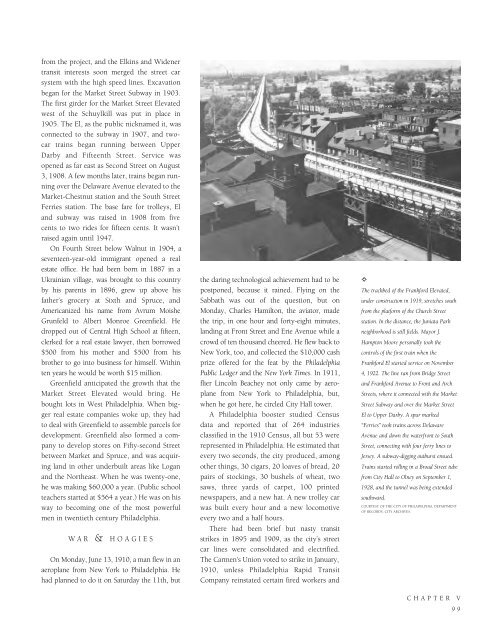Historic Philadelphia
An illustrated history of the city of Philadelphia, paired with the histories of companies, families and organizations that make the region great.
An illustrated history of the city of Philadelphia, paired with the histories of companies, families and organizations that make the region great.
Create successful ePaper yourself
Turn your PDF publications into a flip-book with our unique Google optimized e-Paper software.
from the project, and the Elkins and Widener<br />
transit interests soon merged the street car<br />
system with the high speed lines. Excavation<br />
began for the Market Street Subway in 1903.<br />
The first girder for the Market Street Elevated<br />
west of the Schuylkill was put in place in<br />
1905. The El, as the public nicknamed it, was<br />
connected to the subway in 1907, and twocar<br />
trains began running between Upper<br />
Darby and Fifteenth Street. Service was<br />
opened as far east as Second Street on August<br />
3, 1908. A few months later, trains began running<br />
over the Delaware Avenue elevated to the<br />
Market-Chestnut station and the South Street<br />
Ferries station. The base fare for trolleys, El<br />
and subway was raised in 1908 from five<br />
cents to two rides for fifteen cents. It wasn’t<br />
raised again until 1947.<br />
On Fourth Street below Walnut in 1904, a<br />
seventeen-year-old immigrant opened a real<br />
estate office. He had been born in 1887 in a<br />
Ukrainian village, was brought to this country<br />
by his parents in 1896, grew up above his<br />
father’s grocery at Sixth and Spruce, and<br />
Americanized his name from Avrum Moishe<br />
Grunfeld to Albert Monroe Greenfield. He<br />
dropped out of Central High School at fifteen,<br />
clerked for a real estate lawyer, then borrowed<br />
$500 from his mother and $500 from his<br />
brother to go into business for himself. Within<br />
ten years he would be worth $15 million.<br />
Greenfield anticipated the growth that the<br />
Market Street Elevated would bring. He<br />
bought lots in West <strong>Philadelphia</strong>. When bigger<br />
real estate companies woke up, they had<br />
to deal with Greenfield to assemble parcels for<br />
development. Greenfield also formed a company<br />
to develop stores on Fifty-second Street<br />
between Market and Spruce, and was acquiring<br />
land in other underbuilt areas like Logan<br />
and the Northeast. When he was twenty-one,<br />
he was making $60,000 a year. (Public school<br />
teachers started at $564 a year.) He was on his<br />
way to becoming one of the most powerful<br />
men in twentieth century <strong>Philadelphia</strong>.<br />
WAR & HOAGIES<br />
On Monday, June 13, 1910, a man flew in an<br />
aeroplane from New York to <strong>Philadelphia</strong>. He<br />
had planned to do it on Saturday the 11th, but<br />
the daring technological achievement had to be<br />
postponed, because it rained. Flying on the<br />
Sabbath was out of the question, but on<br />
Monday, Charles Hamilton, the aviator, made<br />
the trip, in one hour and forty-eight minutes,<br />
landing at Front Street and Erie Avenue while a<br />
crowd of ten thousand cheered. He flew back to<br />
New York, too, and collected the $10,000 cash<br />
prize offered for the feat by the <strong>Philadelphia</strong><br />
Public Ledger and the New York Times. In 1911,<br />
flier Lincoln Beachey not only came by aeroplane<br />
from New York to <strong>Philadelphia</strong>, but,<br />
when he got here, he circled City Hall tower.<br />
A <strong>Philadelphia</strong> booster studied Census<br />
data and reported that of 264 industries<br />
classified in the 1910 Census, all but 53 were<br />
represented in <strong>Philadelphia</strong>. He estimated that<br />
every two seconds, the city produced, among<br />
other things, 30 cigars, 20 loaves of bread, 20<br />
pairs of stockings, 30 bushels of wheat, two<br />
saws, three yards of carpet, 100 printed<br />
newspapers, and a new hat. A new trolley car<br />
was built every hour and a new locomotive<br />
every two and a half hours.<br />
There had been brief but nasty transit<br />
strikes in 1895 and 1909, as the city’s street<br />
car lines were consolidated and electrified.<br />
The Carmen’s Union voted to strike in January,<br />
1910, unless <strong>Philadelphia</strong> Rapid Transit<br />
Company reinstated certain fired workers and<br />
✧<br />
The trackbed of the Frankford Elevated,<br />
under construction in 1919, stretches south<br />
from the platform of the Church Street<br />
station. In the distance, the Juniata Park<br />
neighborhood is still fields. Mayor J.<br />
Hampton Moore personally took the<br />
controls of the first train when the<br />
Frankford El started service on November<br />
4, 1922. The line ran from Bridge Street<br />
and Frankford Avenue to Front and Arch<br />
Streets, where it connected with the Market<br />
Street Subway and over the Market Street<br />
El to Upper Darby. A spur marked<br />
“Ferries” took trains across Delaware<br />
Avenue and down the waterfront to South<br />
Street, connecting with four ferry lines to<br />
Jersey. A subway-digging outburst ensued.<br />
Trains started rolling in a Broad Street tube<br />
from City Hall to Olney on September 1,<br />
1928, and the tunnel was being extended<br />
southward.<br />
COURTESY OF THE CITY OF PHILADELPHIA, DEPARTMENT<br />
OF RECORDS, CITY ARCHIVES.<br />
CHAPTER V<br />
99
















